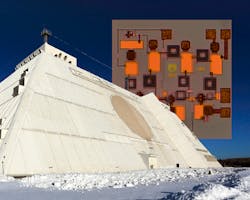Custom MMIC has learned a lot over the past decade about phased-array antennas at the semiconductor level. Specifically, by switching from a depletion-mode to an enhancement-mode GaAs process for an X-band low-noise amplifier (LNA), for example, Custom MMIC’s designers were able to eliminate the negative voltages and voltage sequencers that are a part of a depletion-mode amplifier. Performance benefits were also significant. The enhancement-mode GaAs LNA achieves 1-dB lower noise figure, 8-dB more gain, an eight-fold reduction in DC power, and one-half the unit cost of the earlier depletion-mode LNA design.
In addition, the company leveraged the enhancement-mode amplifier circuit design into a one-chip pair of matched LNAs for boosting the different polarizations of a return signal in a phased-array system. Custom MMIC also worked with their packaging vendor to develop a low-cost QFN plastic package to match the die size of the dual amplifier. The end result was a “standard” product with minimal size, weight, power, and cost (SWaP-C). By taking this “different” approach to the processing of GaAs MMICs, the firm is creating novel MMIC solutions for phased-array radars as well as compact circuits for emerging EW and commercial 5G wireless communications systems utilizing both GaN and GaAs approaches.
The use of an enhancement-mode GaAs PA process provided more power and gain with less power consumption than an existing high-frequency GaAs PA process with a depletion-mode approach. (Graphic courtesy of Custom MMIC).
“We’re learning more everyday about phased array radar and antenna system design challenges,” said Custom MMIC Chief Scientific Officer Charles Trantanella. “Our product design approach has always been to listen and react, and we’re very pleased to have been able to not only deliver the high-frequency performance specifications phased array system designers were looking for, but also the added-value of things like positive bias and positive gain slope characteristics that are proving invaluable in their quest to meet SWaP-C objectives.”
Although depletion-mode pHEMT processes are typically used for ICs, in which a negative voltage is applied to the active device gate and a sequencing procedure is used to prevent device damage by ensuring that the gate voltage is applied before the drain voltage, the need for negative voltage unnecessarily adds to the cost and complexity of a circuit design. Especially in a phased-array system, with potentially thousands of antenna elements and active devices, the opportunity to employ enhancement-mode MMIC devices represented a chance for a large reduction in SWaP-C.
By using an SBIR grant from the U.S. Army, Custom MMIC developed an enhancement-mode power amplifier (PA) circuit in place of an existing depletion-mode PA. It has more gain (5 dB), more power (1 dB), and better linearity than the existing PA, but with 25% less DC power consumption, providing an excellent argument for the use of an enhancement-mode biasing approach. The solution has since been built upon, as seen in its suite of standardized positive bias MMIC amplifiers.
About the Author
Jack Browne
Technical Contributor
Jack Browne, Technical Contributor, has worked in technical publishing for over 30 years. He managed the content and production of three technical journals while at the American Institute of Physics, including Medical Physics and the Journal of Vacuum Science & Technology. He has been a Publisher and Editor for Penton Media, started the firm’s Wireless Symposium & Exhibition trade show in 1993, and currently serves as Technical Contributor for that company's Microwaves & RF magazine. Browne, who holds a BS in Mathematics from City College of New York and BA degrees in English and Philosophy from Fordham University, is a member of the IEEE.


